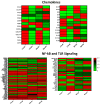Statins Modulate Microenvironmental Cues Driving Macrophage Polarization in Simulated Periodontal Inflammation
- PMID: 37566040
- PMCID: PMC10417531
- DOI: 10.3390/cells12151961
Statins Modulate Microenvironmental Cues Driving Macrophage Polarization in Simulated Periodontal Inflammation
Abstract
Periodontal disease (PD) is a chronic inflammatory disorder characterized by the destruction of connective tissue, tooth loss, and systemic infections. Clinically, treatment of PD includes control of the etiologic factors via several modalities: initial therapy including scaling and root planing (SRP), corrective phase of surgical treatment, both with and without adjunct antimicrobial/pharmacological agents, followed by a maintenance/supportive periodontal therapy phase. Each treatment phase aims to control oral biofilm by addressing risk factors and etiology. Monotherapy of systemic antibiotics is insufficient compared to their use as an adjunct to SRP. The critical issue of systemic antimicrobial usage includes adverse patient outcomes and increased bacterial resistance. Therefore, alternative adjuncts to periodontal therapy have been sought. Statins are widely prescribed for the treatment of hypercholesterolemia and cardiovascular disease. Statins have demonstrated anti-inflammatory properties and immunomodulatory effects, and a few retrospective studies showed that statin patients exhibit fewer signs of periodontal inflammation than subjects without the medication. Despite the available clinical studies on the local administration of statins for PD, no studies have reported the macrophage polarization response. We have developed a gingival fibroblast-macrophage co-culture model to track macrophage response when exposed to a battery of microenvironmental cues mimicking macrophage polarization/depolarization observed in vivo. Using our model, we demonstrate that simvastatin suppresses macrophage inflammatory response and upregulates tissue homeostasis and M2 macrophage markers. Our findings support the usage of statins to mitigate periodontal inflammation as a valid strategy.
Keywords: adjunctive therapy; host immune response; macrophage polarization; periodontal disease; statins.
Conflict of interest statement
The authors declare no conflict of interest. The funders had no role in the design of the study; in the collection, analyses, or interpretation of data; in the writing of the manuscript, or in the decision to publish the results.
Figures




References
-
- Lee J.S., Spooner R., Chowdhury N., Pandey V., Wellslager B., Atanasova K.R., Evans Z., Yilmaz Ö. In Situ Intraepithelial Localizations of Opportunistic Pathogens, Porphyromonas Gingivalis and Filifactor Alocis, in Human Gingiva. Curr. Res. Microb. Sci. 2020;1:7–17. doi: 10.1016/j.crmicr.2020.05.001. - DOI - PMC - PubMed
Publication types
MeSH terms
Substances
Grants and funding
LinkOut - more resources
Full Text Sources
Medical

